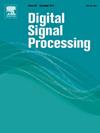Improvement of underwater small target sonar images using fast two-dimensional deconvolution
IF 2.9
3区 工程技术
Q2 ENGINEERING, ELECTRICAL & ELECTRONIC
引用次数: 0
Abstract
The effective detection of underwater small targets largely depends on high-resolution sonar images. Traditional beamformers and matched filters are often used due to their simplicity. However, they have limited angular and range resolution and high sidelobes, which results in insufficient image resolution and image blurring, thus increasing the difficulty of detecting small targets effectively. To improve the sonar system's imaging performance, this paper proposes an underwater small target sonar image enhancement method based on spatiotemporal two-dimensional deconvolution. First, a hyperbolic frequency modulation signal is used as the transmission signal, and the sonar echoes from the far field are received by a uniform linear array. The two-dimensional raw sonar image with azimuth and range information is obtained through traditional sonar imaging methods. Then, spatiotemporal two-dimensional point spread functions are designed, and the modified Richardson-Lucy algorithm is applied along both the angular and range dimensions to deconvolve the raw sonar image. This results in a sonar image with a narrow main lobe and low sidelobes. Finally, simulations and design experiments verify the feasibility of this method. The simulation and experimental results demonstrate that this method can significantly improve target imaging performance, reducing the main lobe width by more than half and suppressing sidelobes to -60 dB. It also exhibits excellent performance in low signal-to-noise ratio (-10 dB) and multi-target scenarios.
求助全文
约1分钟内获得全文
求助全文
来源期刊

Digital Signal Processing
工程技术-工程:电子与电气
CiteScore
5.30
自引率
17.20%
发文量
435
审稿时长
66 days
期刊介绍:
Digital Signal Processing: A Review Journal is one of the oldest and most established journals in the field of signal processing yet it aims to be the most innovative. The Journal invites top quality research articles at the frontiers of research in all aspects of signal processing. Our objective is to provide a platform for the publication of ground-breaking research in signal processing with both academic and industrial appeal.
The journal has a special emphasis on statistical signal processing methodology such as Bayesian signal processing, and encourages articles on emerging applications of signal processing such as:
• big data• machine learning• internet of things• information security• systems biology and computational biology,• financial time series analysis,• autonomous vehicles,• quantum computing,• neuromorphic engineering,• human-computer interaction and intelligent user interfaces,• environmental signal processing,• geophysical signal processing including seismic signal processing,• chemioinformatics and bioinformatics,• audio, visual and performance arts,• disaster management and prevention,• renewable energy,
 求助内容:
求助内容: 应助结果提醒方式:
应助结果提醒方式:


